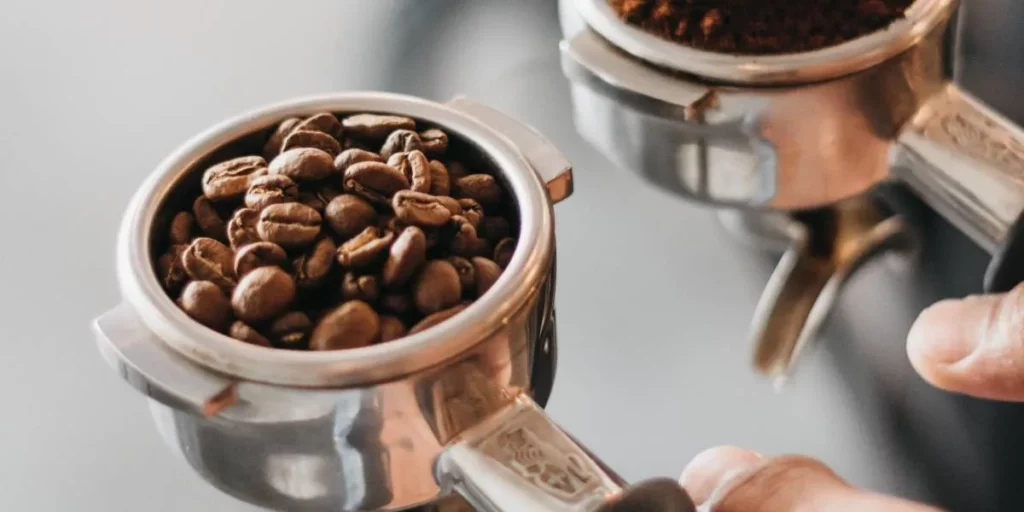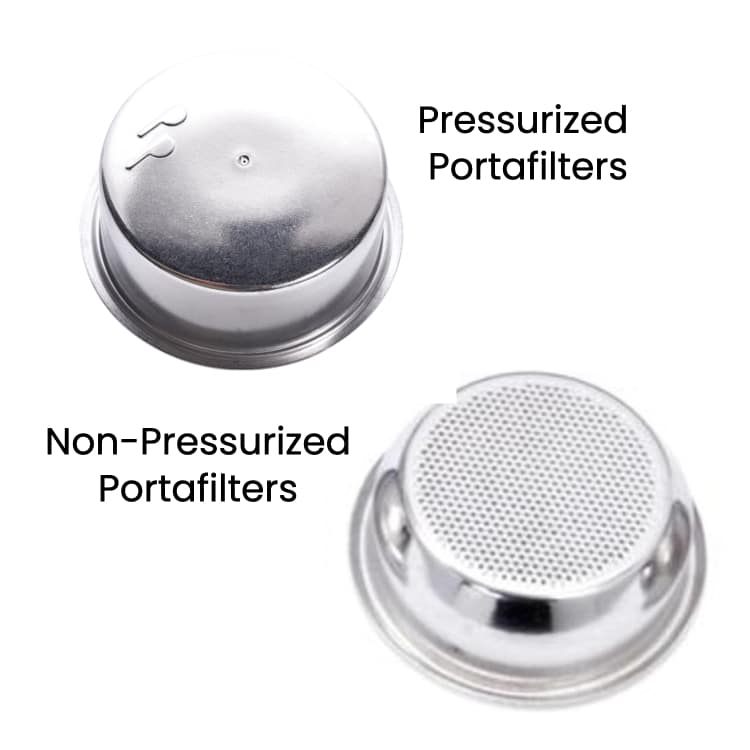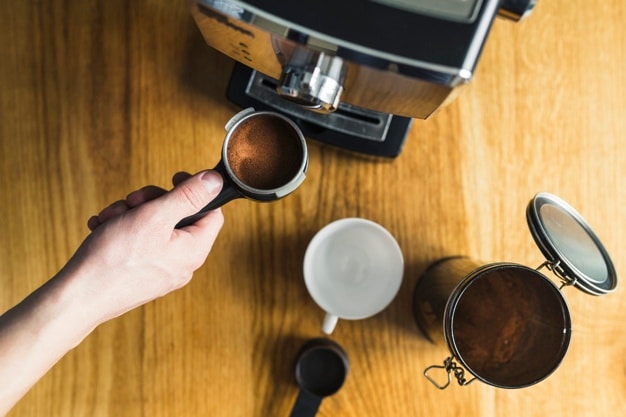If you’re searching for your next coffee machine, you might have already encountered the types of portafilters: pressurized and non-pressurized. Choosing which to consider is a huge decision; this article may help you understand them more!
Portafilter components
Generally speaking, a portafilter is made of stainless steel, brass, or chrome to promote heat retention. However, some parts can be plastic or wood. A typical portafilter has the following components:

- Filter basket: this is placed inside the portafilter’s ring to hold the coffee grounds. It usually has holes that function as a filter through which hot water penetrates to extract the espresso.
- Spout: a usual portafilter may house one or two spouts located at the bottom. This serves as a medium for the coffee to be poured into the cup. But note that there are portafilters with no spout and are called bottomless or naked portafilters.
What are portafilters for?
A portafilter’s basket holds the coffee grounds and is typically removable for easy cleaning and size replacement. Designed with a mesh at the base, portafilters serve as filters as hot water passes through. Additionally, the mesh also helps provide consistency and even coffee extraction.
Here are a couple of scenarios wherein you should use a pressurized filter:
- If you cannot grind fine enough for correct pressure buildup or if you are using pre-ground coffee. The pressurized basket will aid in generating the needed amount of pressure.
- If you are tired of the dialing-in process and just need a shot of espresso immediately.
Pressurized versus a non-pressurized portafilter

You must understand this first: a good espresso requires good extraction of coffee oils. Typically, the finer the grind, the better. If you have an already fine grind, a non-pressurized portafilter can work well with it.
Coffee grounds, which are tamped, will generate the resistance to reach the ideal 8-9 bars of pressure. On the other hand, pressurized filters work best for coarser grinds since fine grind tends to block the dual-wall basket mechanism, which hinders water pressure buildup. Fine grind can essentially choke the coffee machine.
A pressurized filter forces the coffee through a small hole resulting in aeration. This overall results in faux crema or foam. While a pressurized basket is easier to use, the classic espresso taste and mouthfeel are still best achieved with non-pressurized portafilters.
Pressurized portafilter
Pressurized portafilters, also known as pressurized or double wall baskets, house a mesh base with another wall with only one small hole where extraction is forced through to generate more pressure while brewing. Most entry-level home espresso machines house pressurized baskets.
How it works
- Coffee is extracted by the hot water as it flows through the first screen.
- Coffee is pushed out through a single hole in the second screen as pressure elevates.
- Faux crema is formed through aeration while it’s on its way through the next screen and up the spout.
- Espresso then pours into the cup from the spout.

Pros
A pressurized portafilter offers several advantages over a non-pressurized portafilter. The most obvious advantage is that it’s much easier to use. The pressure build-up created by the false bottom helps to create a more consistent extraction.
This makes it a great option for those just starting with espresso-making, as it can help make learning easier. The pressurized portafilter can help to produce a crema with a finer texture, which is desirable in an espresso. Finally, the pressurized portafilter can help reduce the effort needed to pull a shot, as the pressure build-up helps force the espresso through the grounds.
- Improves consistency
- Compensates for lack of precise grind
- Easier to use
- Great for pre-ground coffee
- More crema
- No tricky tamping
Cons
The biggest disadvantage of using a pressurized portafilter is that the pressure build-up can make it difficult to get a good extraction. The pressurized basket restricts the flow of espresso, making it harder to get an even extraction.
This can lead to an over-extracted or under-extracted shot, which can affect the overall taste and texture of the espresso. Additionally, pressurized baskets require more effort to pull shots, as the pressure build-up can make it harder to press down on the portafilter.
- Difficult to clean
- Less control on the user’s end
- May affect the flavor
How to Use a Non-Pressurized Portafilter
Using a non-pressurized portafilter requires more attention to detail than a pressurized one. Before you start, you should grind the coffee beans to the right consistency. You should also ensure that the grinds are evenly distributed in the basket and tamp them down firmly.
Next, add the coffee to the portafilter and evenly distribute the grinds. After that, tamp the grinds down firmly, but be careful not to tamp too hard.
Once everything is ready, you can place the portafilter on the espresso machine and start brewing. You may need to adjust the pressure and temperature of the espresso shot to get the desired result. Once the espresso shot is finished, you can remove the portafilter and enjoy your freshly brewed espresso.
Non-pressurized portafilter
The more traditional type is the non-pressurized portafilter or basket. What makes them different is the lack of a second wall. In simpler terms, nothing else builds the pressure except for the coffee’s grind and your tamping technique.
Professional baristas and coffee lovers prefer this since they have more control over every extraction. For this reason, your grind should be precise. While this is not the easier route, the reward is worth it. Through this, you can have a better-tasting and fuller-bodied cup of Joe.
How it works
- Coffee beans are ground and tamped precisely.
- The espresso machine generates pressure through the coffee’s quality.
- Espresso then pours into the cup.
Pros
A non-pressurized portafilter has its advantages too. Firstly, it allows for more consistent extraction. This is because non-pressurized portafilters have an even dispersion of water over the coffee grounds, which creates a more consistent espresso flavor.
Also, since the water doesn’t have to be forced through the basket, it can better extract flavor nuances from the espresso. This makes non-pressurized portafilters a great choice for experienced baristas looking to perfect their espresso extraction.
- Produces richer flavor
- Controllable extraction and brew
- Fresher crema
Cons
One of the main disadvantages of using a non-pressurized portafilter is that it is more difficult to get the desired coffee extraction results. This is because the size and shape of the holes in the basket make it more difficult to control the pressure, which is paramount for getting the desired espresso flavor and crema.
Also, there is a greater risk of getting over-extraction and bitter coffee if the grind size is too coarse or the extraction time is too long. As a result, getting the perfect shot with a non-pressurized portafilter takes more practice and skill.
- Mastering takes time as correct measurement, grind, and tamping is required
- Fine grind is needed
- Not quick to do
- Pricier as it’s typically found in advanced espresso machines
How to Use a Pressurized Portafilter
A pressurized portafilter is a great way to make a consistent espresso with minimal effort. The pressurized basket creates a pressure build-up which helps to force the water through the grinds, creating an even extraction.
However, it’s important to be aware of some drawbacks of using a pressurized portafilter. This is because the pressurized portafilter can be more difficult to use than a non-pressurized one and can lead to over-extraction if not used correctly.
You should use a good-quality grind to get the best possible espresso with a pressurized portafilter. The grind should be fine, but not too fine, and it should be even throughout. Once you have the right grind, you should tamp the grinds in the portafilter firmly, but not too firmly. This will help to create the necessary pressure build-up in the basket.
Next, you should use a good-quality tamper and make sure that the grinds are evenly distributed. Then, you can use the portafilter to extract the espresso. Make sure you go slowly and evenly and stop just before the espresso drips. This will help to prevent over-extraction. Finally, you should discard the used grinds and clean the portafilter before using it again.
By following these steps, you’ll be able to make a consistent espresso with a pressurized portafilter. However, if you’re a beginner, you may find it easier to start with a non-pressurized portafilter first.
Which one is best for you?
Now that we have already tackled both types of portafilters, the next question is: which one should you get? We all see why a non-pressurized portafilter should be your choice, but don’t be too quick to decide!
Do you always have the luxury of spending long minutes creating your cup of coffee? Or do you have the patience? Are you willing to learn and even master the ropes of perfectly grinding and tamping? Do you always have access to freshly roasted beans? Ask yourself these questions to help you weigh your options.
Take note that whole coffee beans are only considered fresh for about 3 days upon opening. But on a lighter note, the freshness can be prolonged if properly stored in an airtight container. Plus, you should bid goodbye to pre-ground coffee if you want to use a non-pressurized basket.
Another thing to note is that using a single wall basket means you may need more than a built-in grinder. In other words, you’ll need to shell out $400-$500 more for a new grinder. Whether it’s worth the extra cash or hassle depends on you and your lifestyle!
Which Type of Portafilter is Better for Beginners?
When deciding which type of portafilter is best for beginners, it depends on your coffee knowledge and experience level. If you are a beginner with little experience, a pressurized portafilter may be the best option, as it is easier to use and allows for more consistent extraction.
On the other hand, a non-pressurized portafilter is better suited for more advanced baristas who understand espresso and how to achieve the perfect extraction. Ultimately, the type of portafilter you choose will depend on your individual needs and preferences.
Tips for Getting the Perfect Extraction with Your Portafilter
If you want to achieve the perfect extraction with your portafilter, there are a few tips to keep in mind. Whether you are using a pressurized or non-pressurized portafilter, it is important to use the right grind size, tamping pressure, and water temperature.
For the best results, use a medium-fine grind size that is even and consistent. You should also use the right tamping pressure, around 30 lbs for pressurized portafilters and 15-20 lbs for non-pressurized portafilters. Lastly, make sure to use water between 195-205 degrees Fahrenheit. Following these tips will ensure you get the perfect extraction from your portafilter.
FAQs
How do the filters differ between the two types of baskets?
A pressurized basket has an internal screen that filters the coffee into another compartment with a single hole. On the other hand, non-pressurized baskets only have one filter.
What is a dual wall filter?
As the term implies, it refers to another second filter wherein coffee is funneled and pressurized. This is especially true in pressurized portafilters. Essentially, it allows the water to stay in contact with the coffee, so it brews with greater pressure.
Is tamping required with a pressurized portafilter?
The quick answer is NO. You do not need to tamp your coffee with this type of basket. While filling the basket with coffee, brush the ground off and tap lightly to ensure a properly filled basket.
Is it difficult to clean a pressurized portafilter?
Since grinds can easily get stuck into the nooks and crannies, it can be tricky to clean them. But using portafilter cleaners and running water through your machine can help tremendously!
How to clean a pressurized portafilter?
Get a huge glass bowl filled with warm water and sprinkle Cafiza Espresso Cleaning Powder. Soak the filter into the mixture and let that sit for about 5 minutes. After that, rinse thoroughly!
Is a bottomless portafilter better?
Bottomless or naked portafilters are quite cool! It gives you a clear visual field of what goes on in your machine. Another great thing is it lets you monitor if there’s any channeling taking place.
By the way, channeling means pressurized water discovers paths of least resistance resulting in seeing random jets of water and steam instead of a lovely espresso stream. This creates a rather unpleasant-tasting cup. To conclude, bottomless portafilters are better because they provide a cool experience!
Last words
There you have it! We have broken down the difference between pressurized and non-pressurized portafilters so you can choose efficiently. Weight your options by thinking about your lifestyle and willingness to add effort into creating every cup of Joe.
Disclaimer: This post contains affiliate links, which means I may receive a small commission, at no extra cost to you, if you make a purchase using these links. Remember to support us by purchasing through the Amazon/Walmart/Impact Radius links provided. Last update on 2024-04-26 / Affiliate links / Images from Amazon Product Advertising API
Disclosure: No compensation or free products were received in exchange for writing this review.

Editorial Staff
The editorial staff at Crazy Coffee Crave is a team of coffee enthusiasts & Baristas who enjoy the one thing we all think about as soon as we get up in the morning. Trusted by thousands of readers worldwide.





